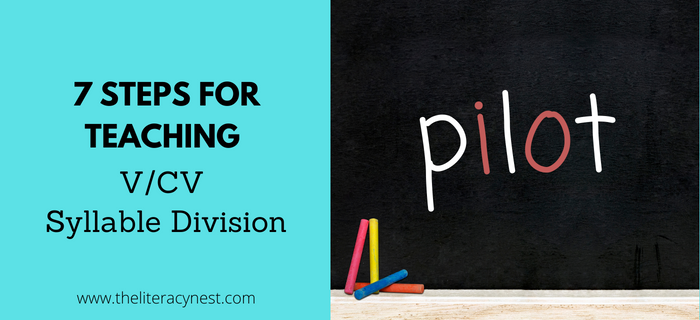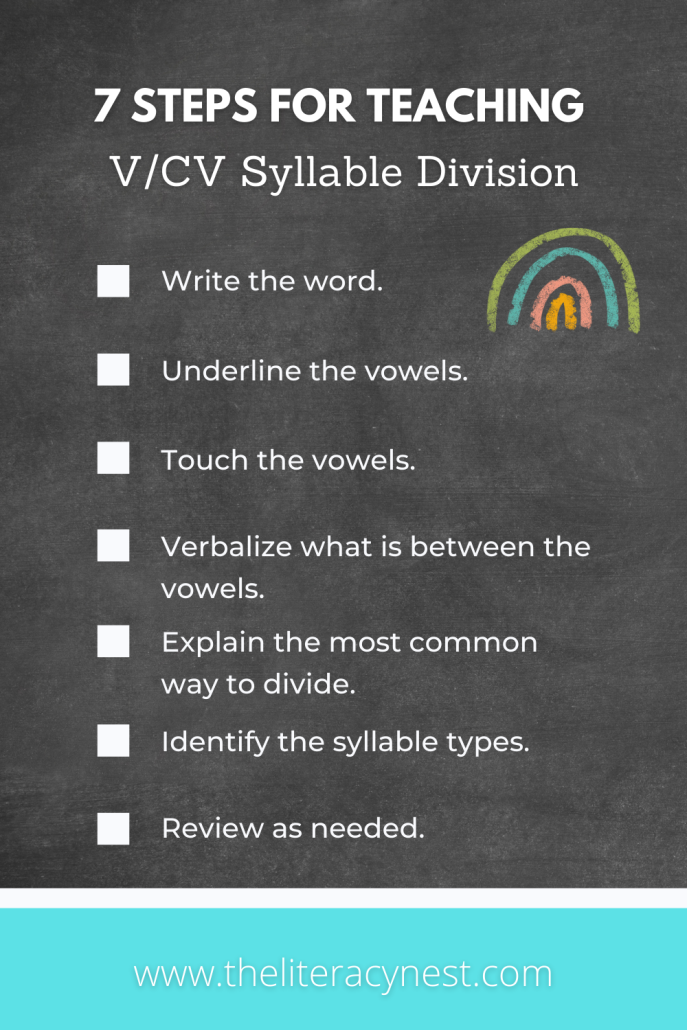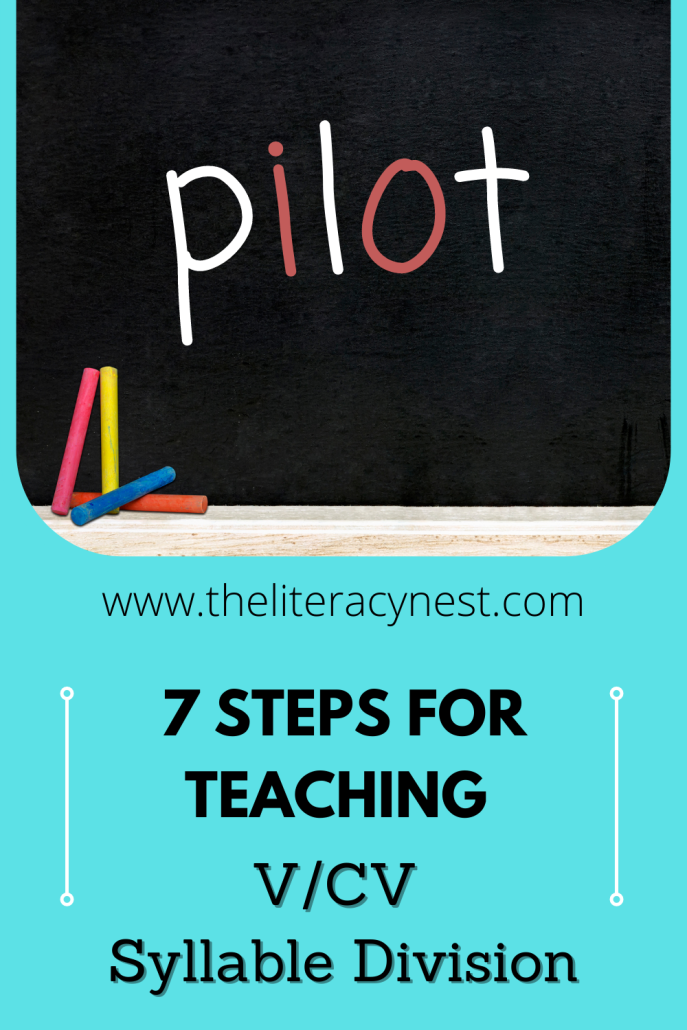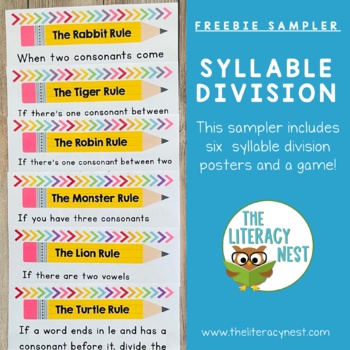7 Steps for Teaching V/CV Syllable Division

There are many reasons to teach syllable division rules. Your students need a procedure to help them tackle long multisyllabic words. Mastering syllable division helps your students to access a much wider variety of printed material. The easiest and most common type of syllable division is division between consonants. In this post, we’ll look at the steps for teaching V/CV syllable division.
If you have not already taught syllable division between consonants, please see this blog post for some tips on doing so: Syllable Division Between Consonants.
When to Teach V/CV Syllable Division
I typically teach V/CV syllable division much later in the sequence of skills. While I teach division between consonants at the end of Level 1 and beginning of Level 2 in my sequence, I typically wait until students are familiar with the first 5 syllable types (Closed, Open (at least in single syllable words), Vowel Team, R-controlled, and Vowel-consonant-e) before introducing this type of syllable division. I like for students to have a thorough working knowledge of vowel teams.
For more on the 5 syllable types, check out my Syllable Series.
V/CV syllable division can be taught in conjunction with open syllables in a multi-syllable word, but extra time may be needed to practice with each vowel.
How to teach V/CV Syllable Division
When students have just one consonant between vowels, it is necessary for students to decide whether to divide the word before the consonant making an open syllable in the beginning or after the consonant making a closed syllable. Because the most common option is dividing after the vowel making an open syllable, I teach this first and provide students with extensive practice in isolation before teaching VC/V division.
I also find it helpful to teach V/CV division BEFORE introducing consonant-l-e syllables. I have found the same technique we used for division between consonants to be very successful for introducing this new concept and for scaffolding for a student if they are struggling with dividing a word later.
Step 1: Write the word.
Write a word in large letters on a chalkboard or whiteboard. If teaching remotely, it is helpful to stretch the word so the spacing between letters is loose on the slide or app you are using.
Step 2: Underline the vowels.
Ask your student to underline the vowels in the multisyllabic word.
Step 3: Touch the vowels.
Ask your student to place their left hand on the first vowel and their right hand on the second vowel. It is helpful to adjust your instructions here to the individual child. For children that struggle with oral language, modeling or providing hand-over-hand support to complete this step may be helpful.
Step 4: Verbalize what is between the vowels.
Ask the student to look in between their fingers and verbalize what they see. At this point, it would be a single consonant.
Step 5: Explain the most common way to divide.
Explain to the student that when there is just one consonant, the most common way to divide is right after the vowel. Model how to mark syllable divisions with a slash or by scooping syllables.
Step 6: Identify the syllable types.
Take the further step of identifying each of the syllable types and marking the vowel sound in the first syllable with a macron.
Step 7: Review as needed.
In my experience the spelling of V/CV words comes quite naturally, however, when this division routine has become more automated, spelling hiccups do sometimes occur and it becomes necessary to review the role that open syllables play in spelling long vowel sounds.

Reinforce with Practice
It is important to provide students with extensive practice and to become comfortable with V/CV syllable division before introducing VC/V division. At some point, you will likely need to review the procedure for V/CV division when providing mixed practice. V/CV syllable division is really a prerequisite for teaching the consonant-l-e syllable type so students are familiar with encountering an open syllable at the beginning of a word. Some examples of V/CV words include raven, tiger, Cupid, behave, and locate. This skill is also a prerequisite for teaching the open syllable exceptions for a and I.
After learning this new syllable division rule, it is important for students to have the opportunity to practice with many examples until this process becomes increasingly automatic. This can be done in a similar fashion as the teaching process, using linking cubes, or cutting word cards. The more difficult a student finds this concept, the more beneficial they will find more exaggerated hands-on approaches such as physically breaking apart the words with building blocks or cutting apart the words. Using small whiteboards or sylla-boards is also helpful when teaching encoding of V/CV words.
The goal…
Ultimately, as this process becomes more comfortable, your students will be able to divide words visually, only using this process as a fallback when something is tricky. It is helpful for many students to mark short vowels with a breve and long vowels with a macron. It can also be useful to indicate syllable type. I typically use C to indicate closed, O for open, and E for Vowel-consonant-e syllables. If students have difficulty identifying V/CV syllable patterns, you may wish to have them code the consonants with a C and Vowels with a V.
While initially, I would suggest presenting words that all follow the V/CV pattern, eventually, you will want to mix VC/CV, VCC/CV, VC/CCV, and V/CV words in word lists and sentences. It can be easy to let earlier skills such as identifying syllable types go as we introduce increasingly complex skills. It is important to constantly be weaving in review to keep students proficient at the foundational skills that will help them read and write more complex words.
Make it Fun!
Almost any game can be used to practice this skill, especially for reading. The only limit is your imagination. An Uno-like game could be matching words with the same color or the same syllable division pattern. A simple board game combined with sylla-boards could have students breaking words correctly or even spelling them in order to roll the dice and move forward.
- Learn more about repurposing games here: Orton-Gillingham Games To Repurpose
- And, learn more about The Importance and Benefits of Playing Games with Your Students from season 1, episode 11 of the Together in Literacy Podcast!
Your students can build words using an assortment of open syllables and ending syllables for a more open-ended game-like activity. Sorting words by the vowel sound in the first syllable can also prove a valuable practice. Repurposed turn-taking games such as Don’t Break the Ice or Jenga are well suited to the gamification of any reading list. Connect 4, Roll and Read, and go fish are low-preparation print-and-go games.
Are you looking for resources to teach syllables?
Well, you are in store for a treat! I have multiple resources available for teaching about syllables and syllable division available in my TpT store! I even have an incredible, multi-sensory, FREE resource you can grab, too!
Check out this fun manipulative for teaching syllable division!
Coming soon…
I’ll be adding a blog post to teach VC/V syllable division soon!






